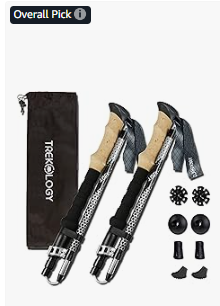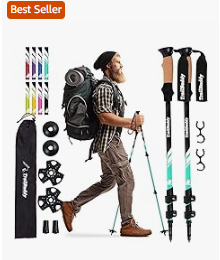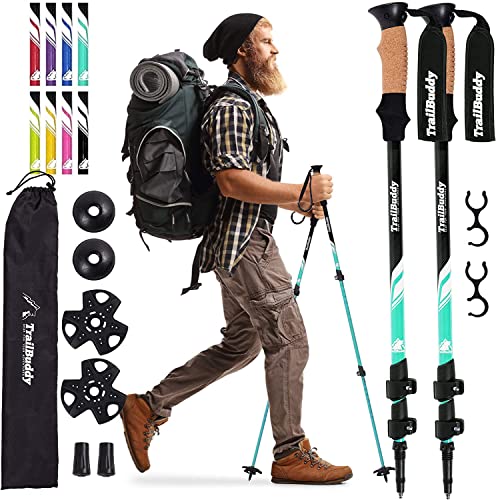Trekking Pole Size Chart Tool
| Height (ft/in) | Height (cm) | Trekking Pole Length (inches) | Trekking Pole Length (cm) |
|---|---|---|---|
| 4’6″ – 5’0″ | 137 – 152 cm | 38″ – 42″ | 96 – 106 cm |
| 5’1″ – 5’4″ | 155 – 163 cm | 42″ – 46″ | 106 – 116 cm |
| 5’5″ – 5’8″ | 165 – 173 cm | 46″ – 50″ | 116 – 126 cm |
| 5’9″ – 6’0″ | 175 – 183 cm | 50″ – 54″ | 126 – 136 cm |
| 6’1″ – 6’4″ | 185 – 193 cm | 54″ – 58″ | 136 – 146 cm |
| 6’5″ – 6’8″ | 195 – 203 cm | 58″ – 62″ | 146 – 156 cm |
Looking for the perfect fit? Check out these Best-Selling Trekking Pole.


How to Choose the Correct Trekking Pole Length
- Standing Posture: When standing upright, the trekking poles should be adjusted so your elbow forms a 90-degree angle when holding the pole’s handle.
- Adjustability: Many trekking poles are adjustable, allowing you to change the length during your hike to accommodate different terrain (e.g., longer poles for uphill and shorter poles for downhill).
- Use: The pole length can vary depending on the type of terrain you’re hiking on. For steep climbs, you may want the pole to be a bit shorter, and for downhill or flat terrain, you may want a longer pole for better support.
Tips for Adjusting Trekking Poles:
- Collapsible Poles: Most trekking poles come with a collapsible design, which allows them to be adjusted easily. If you have adjustable poles, start by adjusting them to the suggested length based on your height and terrain conditions.
- Test Your Fit: After adjusting the trekking poles, hold them in place while standing. If your elbows are not at a 90-degree angle, adjust the length again.
By using this Trekking Pole Size Chart, you will ensure you select the correct pole length for comfort and effective support during your trekking or hiking adventures!
Trekking Pole Size Chart FAQ – Choose the Right Fit for Your Adventure
1. Why does trekking pole size matter?
Using the correct pole length improves balance, reduces strain on knees and joints, and enhances overall trekking efficiency. Poles that are too short or too long can cause discomfort or poor posture.
2. How do I know what size trekking pole I need?
As a general rule:
- For flat terrain, your elbows should form a 90-degree angle when you grip the poles with the tips on the ground.
- Pole length guide by height:
- Under 5’1” (155 cm): 100 cm (39 in)
- 5’1”–5’7” (155–170 cm): 110 cm (43 in)
- 5’8”–5’11” (173–180 cm): 120 cm (47 in)
- 6’0”–6’3” (183–190 cm): 130 cm (51 in)
- Over 6’4” (193+ cm): 135 cm (53 in)
Adjust as needed based on terrain and preference.
3. Are trekking poles adjustable?
Yes! Most trekking poles are adjustable and often feature locking mechanisms (twist lock, lever lock, or flick lock). This allows you to fine-tune the length based on terrain:
- Shorter for uphill
- Longer for downhill
4. Should I use the size chart or go by feel?
Use the size chart as a starting point, but personal comfort and hiking style are also important. Adjust based on your body mechanics and terrain.
5. What if I have a short or long torso compared to my height?
In that case, elbow angle matters more than general height. Stand upright, grip the pole with the tip on the ground, and adjust until your elbow is at a 90-degree angle.
6. Do kids need special trekking poles?
Yes. Kids' trekking poles are usually shorter, lighter, and sometimes come in fixed lengths. Adjustable models are ideal for growing children or shared use.
7. What’s the difference between men’s and women’s trekking poles?
Women’s poles often have smaller grips and slightly shorter maximum lengths to accommodate generally smaller hands and frames. However, many poles are unisex and adjustable.
8. Can I use one trekking pole instead of two?
Yes, but using two poles offers better balance and joint relief, especially on steep or uneven terrain. One pole may be sufficient for flat or light hikes.
9. How do I adjust poles for uphill vs. downhill hiking?
- Uphill: Shorten poles by 5–10 cm to keep your balance forward.
- Downhill: Lengthen poles by 5–10 cm for added support and stability.
10. What if I can’t find my size on the chart?
Go for adjustable trekking poles—they cover a range of heights and offer the most flexibility. If you're unsure, choose a model that spans your estimated size and adjust from there.
Conclusion
Finding the right trekking pole size is key to maximizing your comfort and performance on the trail. Use the height-based size chart as a starting point, but always fine-tune based on elbow angle, terrain, and personal comfort. Adjustable poles offer the greatest versatility and are ideal for most hikers.






